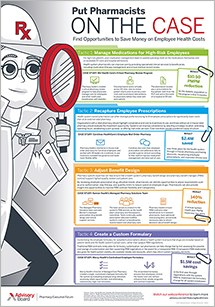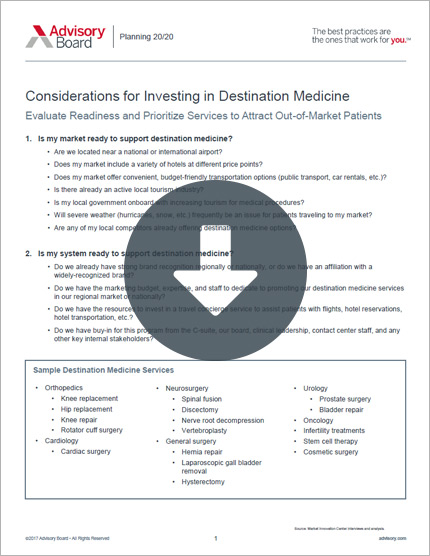Auto logout in seconds.
Continue LogoutGeisinger Health Interim President and CEO Jaewon Ryu recently sat down with Harvard Business Review's Gardiner Morse to share what it takes to be a "center of excellence" (COE) and contract with employers throughout the country to provide high-value care for specified conditions.
Survey results: When will consumers travel for surgical care?
About Geisinger
Geisinger is a large health system based in Pennsylvania. The system consists of 13 hospital campuses, two research centers, a medical school, and a commercial health plan. According to Harvard Business Review, the system "is famously innovative" and was a "pioneer" in COEs and destination-care programs. Under COE arrangements, large employers, such as Walmart, McKesson, and Lowe's, fly their employees to a COE for complex care. These operations yield, "remarkable results," according to Harvard Business Review.
Here's what Ryu said goes into launching one of these centers and keeping it running.
Why Geisinger became a COE
According to Ryu growth was a key driver in turning Geisinger into a CEO. "Being a destination-care provider for employers like Walmart allows us to reach a patient population that isn't already getting its care within Geisinger and is beyond our backyard," Ryu said.
In addition, Ryu said the COE model "aligns really well with how we deliver care." Ryu explained that Geisinger has worked to develop best practice protocols and design workflows around those protocols for a range of "clinical scenarios," such as cardiac surgery, diabetes management, spine surgery, and more. "It's a chassis," he said. "We have the resources, culture, and processes already in place to develop, say, a joint-replacement bundle with an employer."
Challenges (and solutions) to getting started
Of course, launching—and then running—a program like this is not without its challenges, Ryu acknowledged. "Make no mistake—even if you have the chassis in place there's still a lot of work you need to do on the culture to go live with a program like this," he said. "We were lucky—we had a running start, if you will. But even so, it's not something you turn on overnight."
Ryu explained that keeping a value-based program like Geisinger's up and running "takes constant work and vigilance." For example, he noted that hiring new physicians can present an opportunity for unwanted care variation to slip in. To avoid this, Ryu said, "[Y]ou need to make sure they are brought along into [your] organizational approach" from the start. And the key to that, according to Ryu, is transparency.
"Data is probably more visible here than you'd see at just about any other health system," Ryu said.
For example, Ryu explained that at every Geisinger primary care site, there's a whiteboard where the staff gather each morning. The whiteboard shows each provider's appointment availability and a score for how they're doing when it comes to closing care gaps.
"It's taken some work to get us to this point, and admittedly the transparency can be uncomfortable at first," Ryu said. "But it helps us reinforce and support each other in driving for the best outcomes."
When asked how Geisinger handles the discomfort the setup might cause, Ryu explained that "partly there's a socialization that makes it acceptable." He added, "We really try not to do this in an embarrassing or 'gotcha' kind of way." Rather, the goal is, Ryu said, to identify how staff can "learn from each other and improve the overall game."
Advice for other systems that want to become a COE
Ryu said he expects COE programs like Geisinger's to grow in the future because "they address the cost and quality problems employers are struggling with."
With that in mind, Ryu said other health systems that are considering their own COE program should first ask, "Do you have the culture and operational programs and processes in place to succeed with this kind of model?"
Given the overall shift toward value-based care delivery, Ryu said, "There's a huge opportunity for a provider that doesn't yet have these capabilities fully in place to pursue direct arrangements with employers as a way to jump-start the shift."
But Ryu said he expects that destination care for defined episodes is just the beginning. "The broader approach that I expect we'll see a lot more of is … an employer contracting directly with a provider in a prepaid model to take care of a population," he said (Morse, Harvard Business Review, 3/19).
What does it take to be a center of excellence (COE)?
View our resources to learn what it takes to become a center of excellence in three key service lines.
- Cardiovascular | Build the arrhythmia center of excellence
- Oncology | Tumor site centers of excellence
- Orthopedics | Create a market-leading spine care enterprise
Don't miss out on the latest Advisory Board insights
Create your free account to access 1 resource, including the latest research and webinars.
Want access without creating an account?
You have 1 free members-only resource remaining this month.
1 free members-only resources remaining
1 free members-only resources remaining
You've reached your limit of free insights
Become a member to access all of Advisory Board's resources, events, and experts
Never miss out on the latest innovative health care content tailored to you.
Benefits include:
You've reached your limit of free insights
Become a member to access all of Advisory Board's resources, events, and experts
Never miss out on the latest innovative health care content tailored to you.
Benefits include:
This content is available through your Curated Research partnership with Advisory Board. Click on ‘view this resource’ to read the full piece
Email ask@advisory.com to learn more
Click on ‘Become a Member’ to learn about the benefits of a Full-Access partnership with Advisory Board
Never miss out on the latest innovative health care content tailored to you.
Benefits Include:
This is for members only. Learn more.
Click on ‘Become a Member’ to learn about the benefits of a Full-Access partnership with Advisory Board
Never miss out on the latest innovative health care content tailored to you.


